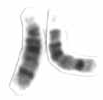| Chromosome 14 | |
|---|---|
 Human chromosome 14 pair after G-banding. One is from mother, one is from father. | |
 Chromosome 14 pair in human male karyogram. | |
| Features | |
| Length (bp) | 101,161,492 bp (CHM13) |
| No. of genes | 583 (CCDS) [1] |
| Type | Autosome |
| Centromere position | Acrocentric [2] (17.2 Mbp [3] ) |
| Complete gene lists | |
| CCDS | Gene list |
| HGNC | Gene list |
| UniProt | Gene list |
| NCBI | Gene list |
| External map viewers | |
| Ensembl | Chromosome 14 |
| Entrez | Chromosome 14 |
| NCBI | Chromosome 14 |
| UCSC | Chromosome 14 |
| Full DNA sequences | |
| RefSeq | NC_000014 (FASTA) |
| GenBank | CM000676 (FASTA) |
Chromosome 14 is one of the 23 pairs of chromosomes in humans. People normally have two copies of this chromosome. Chromosome 14 spans about 107 million base pairs (the building material of DNA) and represents between 3 and 3.5% of the total DNA in cells.
Contents
The centromere of chromosome 14 is positioned approximately at position 17.2 Mbp.

